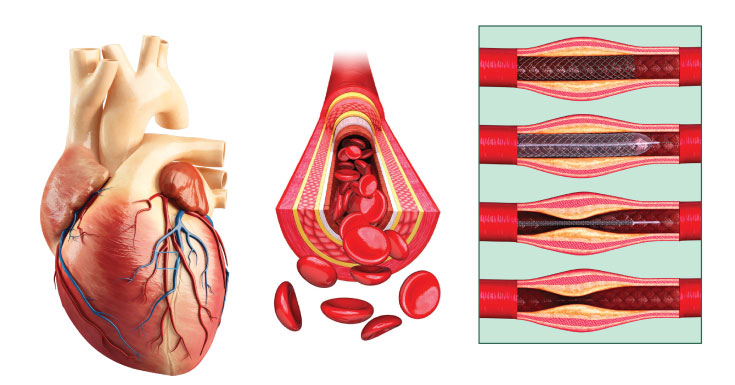Cardiovascular disease is an umbrella term covering a group of disorders. This includes Coronary heart disease which affects the blood vessels that supply the heart, a cerebrovascular disease which affects the blood vessels that supply the brain and peripheral artery disease which affects the blood vessels that supply the arms and legs. Cardiovascular disease encompasses this group of disorders affecting the heart and blood vessels that supply all the vital organs. Natural Health talked to Dr Lim Chiao Wen of Pantai Hospital Cheras to uncover more about this dangerous, life-threatening disease, and the following are her responses.
Part 1: Cardiovascular disease in Malaysia
Q: What are the most common types of cardiovascular disease among Malaysians?
Dr Lim: In Malaysia, the most common form of cardiovascular disease are coronary artery disease or ischaemic heart disease. Cardiovascular disease predominantly ischaemic heart disease is the number 1 cause of mortality followed by cerebrovascular disease.
In 2019, ischaemic heart disease recorded the highest percentage of mortality at 16% which is the most common cause of death in Malaysia and even worldwide.
Q: What are the frequent causes of these cardiovascular diseases here in Malaysia and are there any tips to overcome them?
Dr Lim: The causes ties back to the risk factors. Major causes are high cholesterol, high blood pressure, diabetes and lifestyle habits such as smoking, excessive alcohol consumption, and obesity. In urban areas, cases of premature coronary heart disease are due to stress. This reflects back to the lifestyle and risk factors that contribute to the disease itself. Practising a healthy lifestyle is still the golden way to avoid falling victim to cardiovascular diseases.
Part 2: Coronary Artery Disease
Q: What is coronary artery disease (CAD)?
Dr Lim: CAD is a disease that affects the blood vessels and arteries that supply the heart.
Q: What is the most common cause of CAD?
Dr Lim: CAD is caused when there is a progressive buildup of cholesterol which forms plaque in the arteries. Over time, this buildup will cause a blockage or narrowing of vessels.
When there is a blockage and the blood vessel is narrowed, the supply of oxygen to the heart will deplete.
Q: What are the symptoms of CAD?
Dr Lim: With the significant drop of oxygen in the heart muscle, patients will experience symptoms such as chest pain or discomfort, and breathlessness when carrying out activities and when exerting themselves.
In severe cases, patients may also experience fainting, unstable heart rhythm or in the worst scenario – cardiac death due to a heart attack.
Q: What does the current statistic for CAD look like among Malaysians?
Dr Lim: According to statistics provided by the National Cardiovascular Database registry, male patients make up about 80% while the female is 20%.
Q: Who is more susceptible to CAD, male or female?
Dr Lim: CAD is a worldwide disease and not only exclusive to Malaysia. There is a male dominance to this disease.
Q: How does one gets diagnosed with CAD?
Dr Lim: Diagnosis is usually done by looking into the patient’s history. Additional tests such as an electrocardiogram (ECG), blood test and echocardiogram will be conducted to determine whether a patient has CAD.
For patients who are elderly or experience mobility issues, tests such as dobutamine stress test or imaging test such as CT coronary angiogram is conducted.
When preliminary tests are pointing to a high chance of CAD, an invasive procedure – coronary angiogram will be advised to patients.
Q: Can CAD be treated with drugs or a stent?
Dr Lim: This depends on the degree of the patient’s CAD. It is divided into obstructive CAD and non-obstructive CAD. Obstructive CAD is when there is a blockage or narrowing that has caused significant depletion of oxygen to the tissue. In this situation, patients will need to receive an angioplasty stent or Percutaneous transluminal coronary angioplasty (PTCA).
In patients where there is no obstruction, where the blockage is not severe enough to cause disruption in blood or oxygen flow to the muscle, they can be treated with optimal medical therapy with drugs to reduce the risk of progression of the narrowing and heart attack in the future.
Q: How does a stent help CAD patients?
Dr Lim: Imagine the vessel as a narrowing in your water pipes, and there is a blockage. The stent then is placed to open up the blockage. We will need a balloon to open up or flatten the blockage. The stent which is made of metal material is then placed to hold the vessel and ensure that the blockage that has been opened stays open.
It helps to relieve symptoms of angina (chest pain) and reduce the risk of a heart attack in the future.
Q: With emerging newer types of stents in the market available for patients, what are the options that are available and how can one know if the stent suits the certain individual?
Dr Lim: In general, although there are many types of stents in the market, the idea is still the same. The newer stents are thinner in structure, easier to deliver and also low risk of narrowing in the stent in the future. The commonly used stent in the market now is the drug eluting stent. This metal stent is impregnated with drugs and placed into the blood vessel, the design of the stent allows the delivery of the drugs onto the blood vessel lining and prevents re-narrowing of blood vessels.
Q: How long is the procedure and what is the procedure like?
Dr Lim: The process these days has been simplified. The most common approach is the radial approach: from the wrist of the patients, for patients’ comfort and convenience.
On average coronary angiogram takes 15-20 minutes and angioplasty with stenting may take up to an hour, or in complex procedures, it may take up to 2 hours. It’s a procedure that involves minimal sedation.
Q: If a patient has done stenting, will there be a disease recurrence?
Dr Lim: There is always a risk, unfortunately, especially if individual risk factors such as diabetes, blood pressure or cholesterol remain uncontrolled.
Q: How can patients ensure a healthy heart condition post-stenting procedure?
Dr Lim: The important key message for patients to take home is what they need to do to alter their lifestyle or how they can control the risk factor that caused it in the first place. Cholesterol level is monitored closely for the target level as well as diabetes. In terms of Lifestyle, they have to stop smoking and only consume a moderate amount of alcohol. Not forgetting healthy eating and regular exercising in moderate intensity.
Q: What are instances that a pacemaker is needed for a patient?
Dr Lim: There are three instances where a pacemaker is needed. One is when someone has a heart rate that is too low, making them symptomatic. Or their heart rate is too fast which gives them life threatening or unstable conditions. This requires them to get a defibrillator pacemaker. Another circumstance where a pacemaker is needed is when patients have chronic heart failure, so the pacemaker is needed for cardiac resynchronisation.
Q: How does a pacemaker work?
Dr Lim: When a pacemaker detects the irregular heart rate it kicks in and generates an impulse for sufficient heart rate to sustain blood pressure and bodily function. When a pacemaker is implanted for someone who has the tendency for irregular heart rhythms that are life threatening, the pacemaker detects this and sends an electric shock to help restore to the normal rhythm. In terms of patients who receive pacemakers for chronic heart failure, the idea of it is to help synchronise the heart contraction to relieve the symptom of heart failure.
Q: How long does the process of getting a pacemaker take?
Dr Lim: This depends on the type of pacemaker. In general, placing a pacemaker involves implanting it through the venous system. It is implanted into the right side of your heart and takes an average of an hour. Pacemakers for patients with heart failure may take up to 2 hours. Again the procedure is done on minimal sedation as well.
Q: What are the common lifestyle activities can patients with pacemakers do to keep healthy?
Dr Lim: The most important is to encourage the patients to carry on with their daily physical routine. Patients with pacemakers usually have cardiac rehab that tailors their activities and exercises according to their heart function.

Pantai Hospital Cheras

















